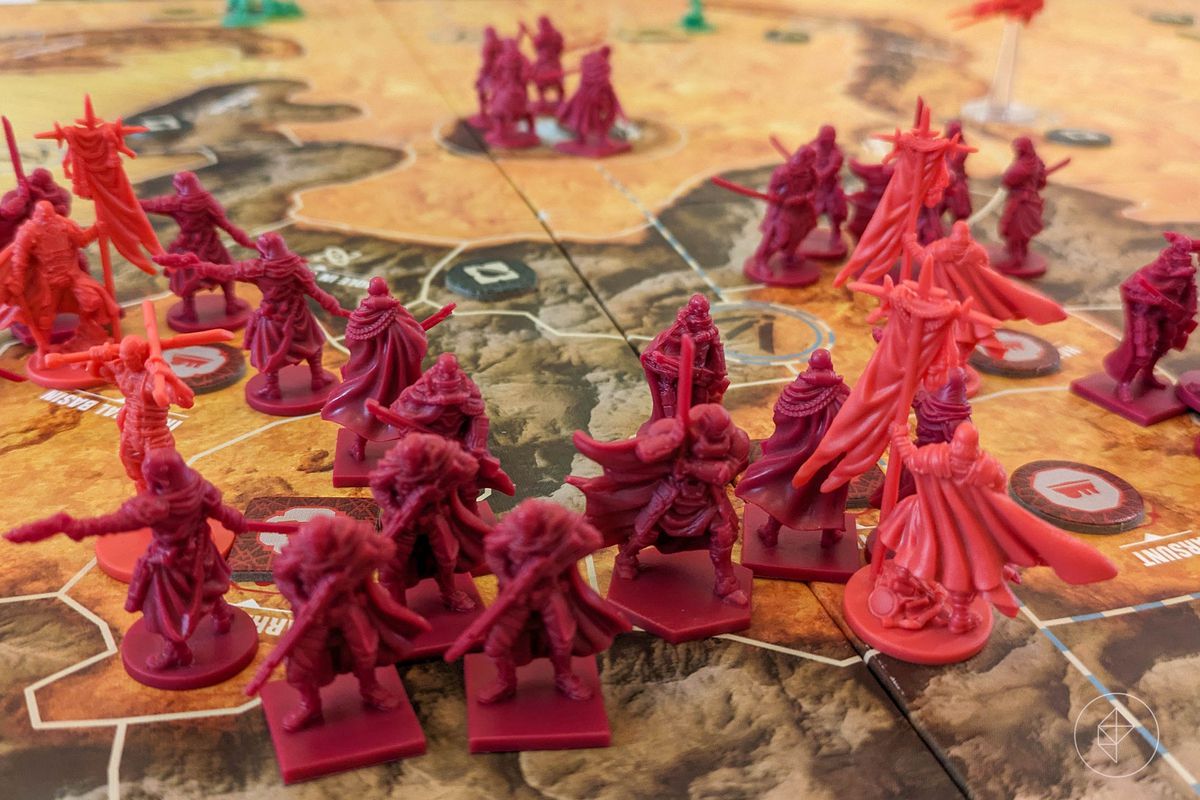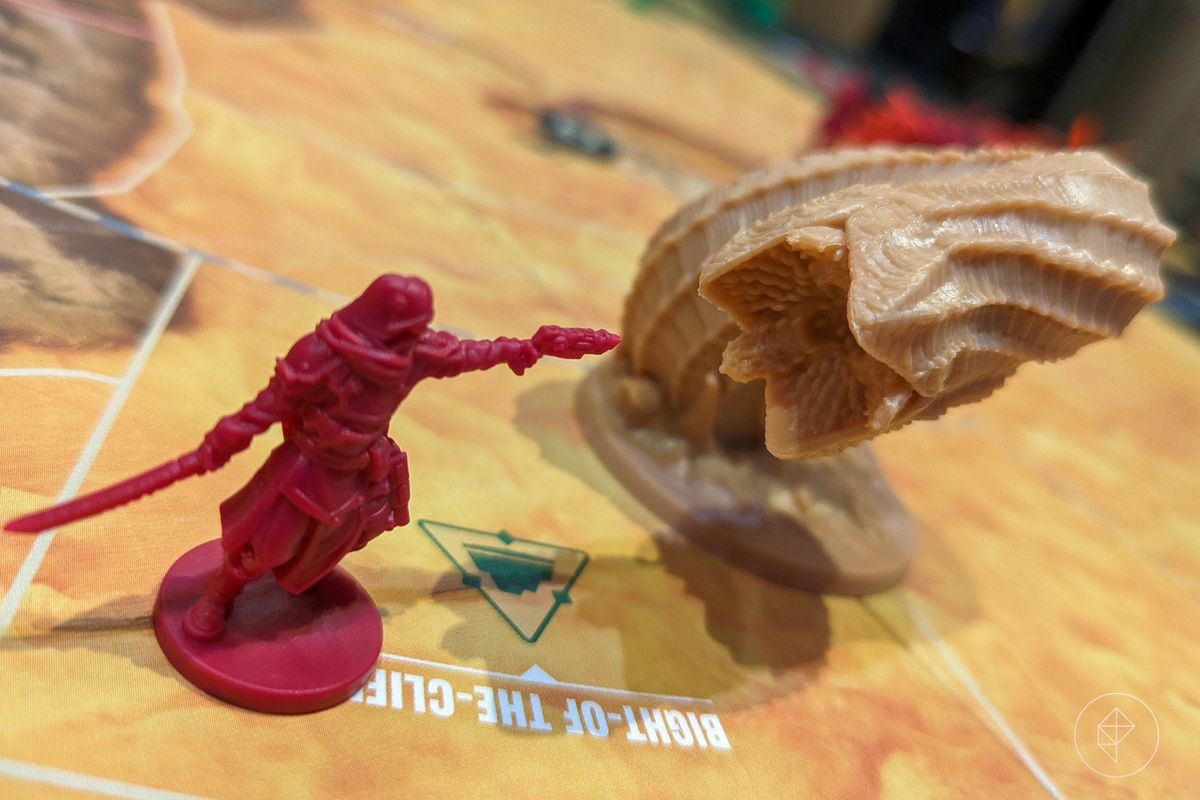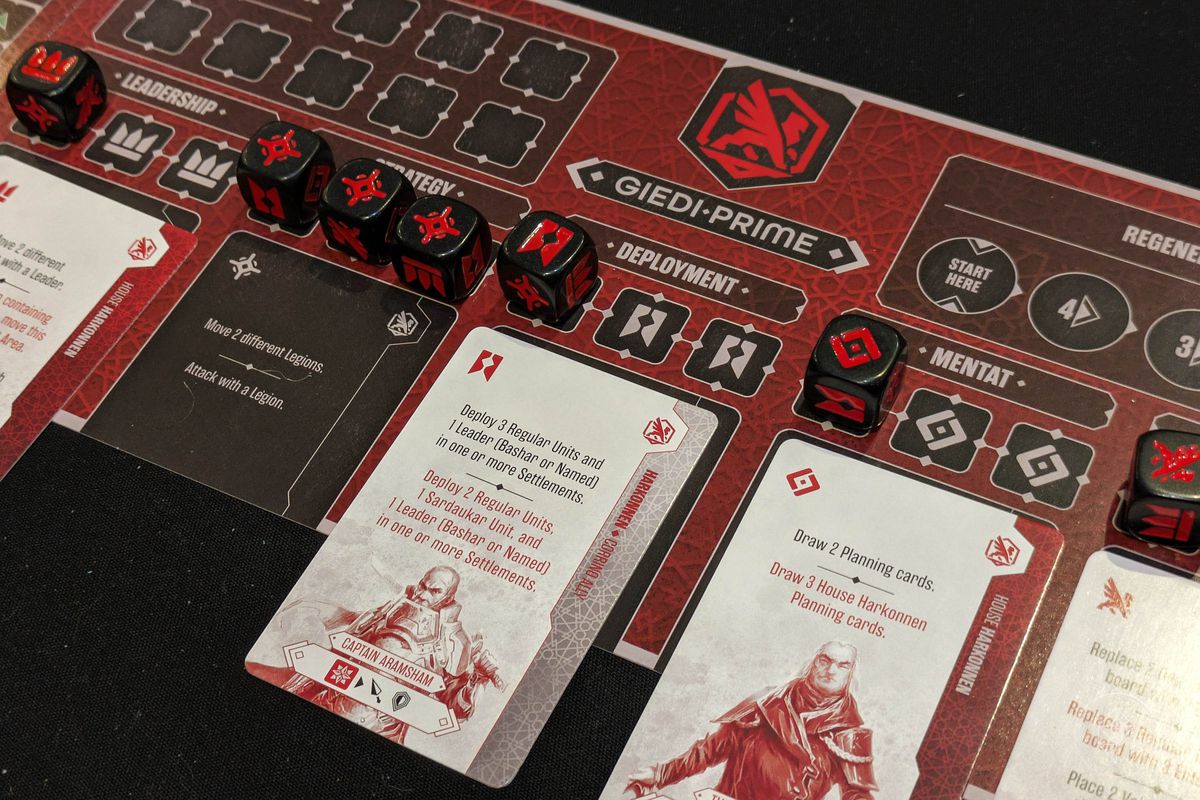Dune: War for Arrakis, one of the best board games of 2024, squeezes an epic into 2 hours
As if predestined by the Bene Gesserit, Dune: War for Arrakis arrived at the perfect time. This grand strategy game was created in the wake of Dune: part two, Dennis Villeneuve’s follow-up film depicting the second half of Frank Herbert’s seminal novel. Like the film, this board game depicts the escalating desert war between the deposed House Atreides and the usurping House Harkonnen. Both film and games have a second quality in common: they are spectacular media that can be aptly described as works of art.
The duo responsible for Dune: War for Arrakis are Marco Magi and Francesco Nepitello. The bones of the game bear the mold of this team’s previous release, a board game titled War of the Ring, which centers on the legendary battle in the Lord of the Rings trilogy. It’s an epic experience with clashing armies And the march to Mount Doom And all the major characters in Tolkien’s novels. War of the RingThe best aspect of the game is the tactical dice system that controls the flow of the game and puts together the game loop. This is the main element being transferred to Dune: War for Arrakis.
Each turn, both players throw a stack of dice. These custom six-siders have different action icons and the results determine what you can do during the round. The game then consists of going back and forth from Atreides to Harkonnen, with each player allocating a die and performing an action.
This is a simple system. You spend a die to recruit or move troops. You can also play special cards from your hand to create nasty surprises or launch massive attacks. The dice pool acts as a constraint, forcing players into tough spots where you can’t execute a plan perfectly. The tactical challenge lies in how you use your options to shape the board to your advantage.
Image: CMON
The victory is also nuanced. The Atreides have a tougher assignment, as they must focus on a small assortment of targets dealt out from the Prescience deck each turn. These encourage various maneuvers that largely build on the novel’s story, such as Paul drinking the Water of Life or Atreides using their Fremen warriors to attack vulnerable harvesters. They focus play on temporal considerations, forcing adaptation and bending to the environment – two central themes that run through Herbert’s novel.
There is also an incentive to check the ecological stations spread across the map. These form hotspots, as the Harkonnen player will usually try to defend them. Finally, Atreides will move closer to success by taking Harkonnen strongholds such as the North Pole and Arrakeen. These are always well defended and pose a significant challenge, but with resources such as the ferocious sandworms and the elite Fedaykin troops, such an offensive is possible.
The Harkonnen player has it a bit easier. Instead of pursuing dynamic objectives that change every round, they simply need to destroy 10 points of Fremen bases. The value of each sietch is hidden, but this number can be scouted with ornithopters and with clever card play. This is the more blunt faction, which relies on raising legions of troops to exterminate and destroy the native Fremen. It highlights the alternative philosophies of each house and features one of the novel’s many motifs.

Both the battle and the integration of appointed leaders on the battlefield are reminiscent War of the Ring. Violence is simple: each unit adds a die that grants a hit, shield, or special leader buffs. Shields neutralize hits and the rest count as casualties for the army. The special leader improvements are the most intriguing aspect. For example, Baron Harkonnen will provide defense, while The Beast Rabban will provide extra blows. The special forces – Fedaykin and Sardaukar – add even more texture by taking multiple hits and nullifying the opponent’s defensive results. While this is simple and easy to internalize, it proves to be a surprisingly powerful offensive toolset that can lead to devastating results. Combat is resolved quickly and logically, framing dramatic moments that punctuate the gameplay and support the game’s larger storyline.
Besides conflict, the leaders are an important aspect because of the way they improve players’ actions. With Paul you can perform a special action that gathers several legions towards him. Rabban can perform a powerful double move that allows you to attack behind enemy lines and achieve separation. Still other leaders influence the acquisition of cards or place special units on the board. As the story develops, new leaders come into play. The result is a unique story path with every playthrough, with some sessions never even witnessing the Reverend Mother or the great Wild Maker.

There are a lot of details here. The asymmetry of the two forces is a big part of the attraction. The Atreides/Fremen forces can drive worms through the desert with impunity, while the Harkonnen legions left in the open desert are exhausted by storms every round. Herb gathering is an integral part of preserving the rest of the empire and maintaining their economic advantage for the Harkonnen. There is bluffing and secrecy through hidden units and vicious card play. Despite all these details and the large amount of content, the game finishes in a surprising two hours. It is shocking how this framework is exceptionally capable of delivering a complete storyline with depth and precision within the allotted time.
Much of the performance is the result of iterating by the design team War of the Ring, now in its second edition. Adjustments to leaders represent a significant improvement over that game, as they are now decoupled from the bonus dice they grant in Middle-earth. Here on Arrakis the action system is more satisfying, as Atreides possess fewer dice, but can in turn perform the clever worm drawing action – effectively manipulating the environment – rather than simply standing and waiting for their opponent to spend their extra dice. The time commitment is much shorter, like War of the Ring requires most of the day to set up and play. Additional minor improvements have been found in combat, the map system, and the overall game flow. The result is an experience set at this beautiful intersection of grand strategy wargaming with a more personal and intimate composition.
Despite this praise, it’s important to understand that this is primarily a two-player game. It can function as a four-player venture with each faction split in half between a pair of players, but this is far less satisfying in practice and undermines some of the design’s strengths. If a group of four players is looking for something to play, they would be much better off looking elsewhere.

Of greater importance is the issue of factional balance. Michele Garbuggio, a developer who worked on this game to support the design team, did that declared that “through precise design intent (Dune: War for Arrakis) is not balanced on a 50/50 win ratio… it’s more of a 60/40… in favor of the Harkonnen.” The intention behind this reflects the power differential between the armed forces and the miraculous rise of the Kwisatz Haderach to the to lead scattered Fremen. This does not detract from the overall strength of the design. The vast majority of participants will practice this game casually and not in tournament form, and in this more relaxed environment it has little consequence.
Despite these minor concerns, Dune: War for Arrakis burst out of the sand with ferocity. This game offers an epic experience packed with drama and moments of grandeur. It successfully condenses and refines many of the concepts from the designer’s previous work, producing a special game that has its own identity. 2024 is only halfway through, but it may already have received its best title.
Dune: War for Arrakis is currently available at retails for $123. It is also available as a special Gamefound pre-order campaign where, in addition to a new expansion, additional content from the original Kickstarter campaign is once again available.
